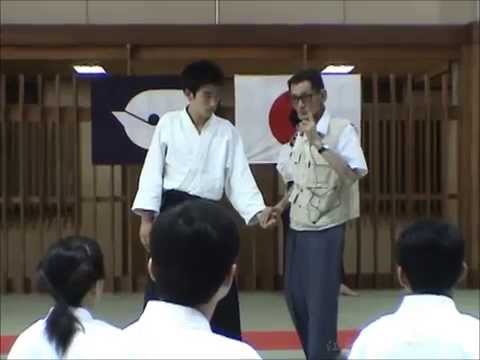 Yoshio Kuroiwa (黒岩洋志雄) at the Edogawa Aikido Renmei in 2005
Yoshio Kuroiwa (黒岩洋志雄) at the Edogawa Aikido Renmei in 2005
Yoshio Kuroiwa was born in Tokyo Japan in Showa year 7 (1932). In Showa year 21 (1946) he joined the Nippon Kento Club (日本拳闘倶楽部) founded by the father of boxing in Japan, Yujiro Watanabe (渡辺勇次郎), with the intention of becoming a professional boxer. Forced to give up his dreams of a boxing career due to eye injuries, he entered Aikikai Hombu Dojo in Showa year 28 (1953), where he established a research group that would become known as the “Kuroiwa Gakko” (“Kuroiwa School”). Kuroiwa Sensei passed away on January 19th 2010.
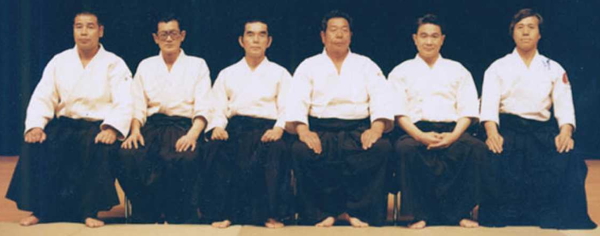 Yasuo Kobayashi, Yoshio Kuroiwa, Kanshu Sunadomari,
Yasuo Kobayashi, Yoshio Kuroiwa, Kanshu Sunadomari,
Morihiro Saito, Shoji Nishio, Mitsugi Saotome
First Aikido Journal Friendship Demonstration, Tokyo – 1985
Kuroiwa Sensei published two articles in the Aikido Journal magazine: Training and Cognition and A Common Sense Look At Aikido. If you are interested in more about Kuroiwa Sensei you may also with to read Ellis Amdur’s tribute to his passing from AikiWeb – In Memory of Kuroiwa Yoshio.
This section of the interview introduces a little bit about the “Kuroiwa Theory” of Aikido. Here’s a little bit more on this theory, from a separate conversation with Kuroiwa Sensei:
People think of Ikkyo or Shiho-nage as single techniques and train them that way – later on that really screws them up!
The meaning of Ikkyo is to de-stabilize the opponent “vertically” from one’s own perspective. That moves from Ikkyo to Nikyo, Sankyo and Yonkyo – put another way, Ikkyo is an upper de-stabilization, Nikyo is a middle de-stabilization, Sankyo is a lower de-stabilization and Yonkyo is right on the ground.
Then Shiho-nage is to de-stabilize the opponent “horizontally” from one’s own perspective. Here things get deeper when one’s own movement gets added on and one moves in a spiral.
The meaning of Ikkyo is to de-stabilize the center of gravity of one’s opponent vertically, and Shiho-nage means to de-stabilize the posture of the opponent horizontally. Here one has the vertical and the horizontal and Yin-Yang (In-Yo) appears. From the beginning this In-Yo isn’t two separate things, it is just one thing that changes according to the way that one looks at it. For example, I place a stick horizontally and say “this is horizontal”, but when I look at it while lying down it appears to be vertical. So from the beginning they are one thing! It just appears to be vertical or horizontal, there is actually only one thing. To that point, if one just continues to practice without understanding the meaning of Ikkyo or the meaning of Shiho-nage then in the end it becomes simply external training.
In the case of Aiki, words such as Ikkyo or Shiho-nage are usually used to describe the basic techniques, but one must understand that what is important is the vertical movement from Ikkyo to Yonkyo, and the horizontal movement from Shiho-nage.
However, at its heart it’s impossible for one to think of de-stabilizing an opponent vertically or horizontally from the very beginning. After all, in this world one thinks of things realistically, since one doesn’t exist in this world by themselves – for example, that things are seen through their contact with others. So, if one conceives of vertical movement as this or horizontal movement as that – as the result of attempting to match oneself to the opponent’s movement in relation to oneself, then one won’t be able to escape being captured by kata.
This is the second part of a two part interview with Yoshio Kuroiwa that originally appeared in the January 2006 issue of Gekkan Hiden (月刊秘伝 / “Secret Teachings Monthly”), a well known martial arts magazine in Japan. You may wish to read Part 1 of this interview before reading this section.
This interview was also published in a collection of interviews with students of the Founder published in Japanese as 開祖の横顔 (“Profiles of the Founder”) in 2009. There was a short introduction to this work in the article “Morihei Ueshiba – Profiles of the Founder“. A number of English translations of interviews from that collection appeared have appeared previously – Nobuyoshi Tamura Sensei (Part 1 | Part 2), Hiroshi Isoyama Sensei (Part 1 | Part 2), Shigenobu Okumura Sensei (Part 1 | Part 2), Nobuyuki Watanabe Sensei (Part 1 | Part 2), Masatake Fujita Sensei (Part 1 | Part 2) , Yoshimitsu Yamada Sensei (Part 1 | Part 2), Kanshu Sunadomari Sensei (Part 1 | Part 2) and Hiroshi Kato Sensei (Part 1 | Part 2).
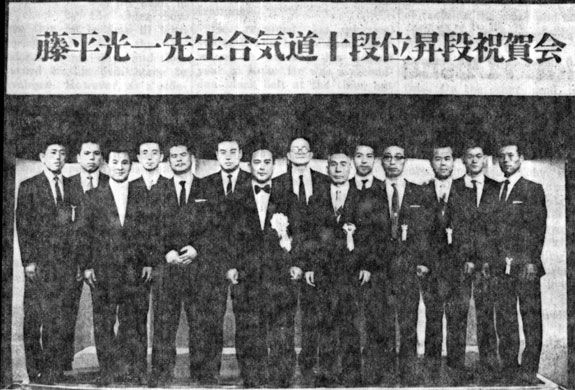 At the celebration for Koichi Tohei’s promotion to 10th Dan, October 16th 1970
At the celebration for Koichi Tohei’s promotion to 10th Dan, October 16th 1970
Yoshio Kuroiwa second from right between Mitsugi Saotome and Akira Tohei
Interview with Aikido Shihan Yoshio Kuroiwa – Part 2
O-Sensei’s eye sparkled with light
Q: Did you see the Founder in class?
A: About once a month. He was mostly in Iwama, but every now and then he’d come and suddenly be seen in class. Then he’d whip off two techniques or so in a flash and vanish into the back. There was no oral instruction given. He wouldn’t show a technique more than once, saying “If I do a technique twice it will be stolen”. One of his favorite phrases was “technique isn’t something that’s taught, it’s something that’s stolen”. It seems paradoxical, though. So I think that one time would be about ten minutes long.
Q: What did if feel like to take ukemi for him?
A: He was very soft, fluffy. O-Sensei was extremely gentle and kind, but there was someplace in him that was frightening. I remember that his eyes would often sparkle with light.
Q: I’ve heard that his lectures were very long…
A: I hated those things. (laughing) He’d speak about things like the Kojiki, but I didn’t understand what he was talking about and my legs would fall asleep, it made me cry! Thinking about it now I feel nostalgic.
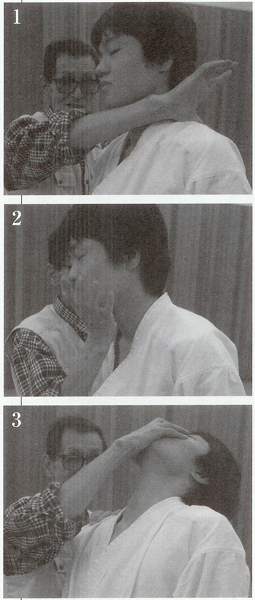 “O-Sensei said ‘If the palm hits the jaw then the fingers will enter the eyes’”
“O-Sensei said ‘If the palm hits the jaw then the fingers will enter the eyes’”
The Kuroiwa Theory – created three days after beginning Aikido
Q: I’ve heard that you realized “Aikido training is truth and untruth” three days after you started…
A: That’s right. Grabbing the opponent’s wrist is the untruth of agreed-upon practice (“yakusoku geiko” / 約束稽古). The truth is in what you yourself apply, so it is a training (稽古 / “keiko”) of truth and untruth.
Q: How did you come to this realization?
A: It’s because I was a boxer. Because boxing is the world of truth. I realized that the way that one uses their body is the same as the upper-cut, the hook and the straight punch in boxing.
Q: You mean that it’s not the type of punch, but the way that one holds their body when they strike?
A: Yes. The upper-cut is a vertical movement, Ikkyo, the hook is a horizontal movement, that’s Shiho-nage, isn’t it? So when I learned Ikkyo I realized “Ah!”, it’s not just a name for a technique for grabbing the elbow, it’s the essence of (vertical) de-stabilization. That’s why I opposed it when Hombu later tried to use Ikkyo as “a method for controlling the elbow” – it just cheapens the technique. It’s a foundational principle, so you can’t limit it’s usefulness like that. If you make it a technique for “controlling the elbow”, won’t development stop at that point? That’s not what it is at all.
Q: You really realized that after three days?
A: Realizing something takes between three days and a week. If one has questions and doesn’t resolve them immediately then they just continue on with the questions unresolved. After a year goes by one forgets that they even had a question.
Q: However, not everybody is receptive to that way of thinking, isn’t that true?
A: That’s right. One becomes disliked. (laughing) I think that the basics of today’s Aikido today are from Yamaguchi Sensei’s magnificent Aikido. Maybe about 95 percent.
Q: This is difficult to ask, but apart from your formulation of an original theory of what might be called “Kuroiwa-ryu” shortly after starting Aikido, why didn’t you choose to follow your own original path?
A: Well, in the end that was due to my attraction to O-Sensei. I felt “Nihon Budo” in O-Sensei’s bearing. Also, I had good friends like Tamura-san and Noro-san.
Q: What was the Founder like when he was with you?
A: It’s not as if I spent that much time with him, but when I went out with him he was nervous. When we rode in a taxi he would would shout “Look out!” to the passengers in back the whole time, and the driver would become angry at him. In the end, I guess that a Budoka must be so cautious that it is almost cowardice.
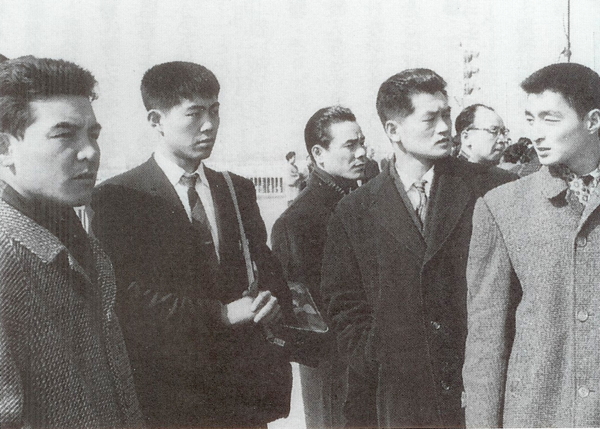 Seeing off Hiroshi Tada on his departure for Italy
Seeing off Hiroshi Tada on his departure for Italy
From right: Yoshimitsu Yamada, Yoshio Kuroiwa, Toshiyuki Arai
My Aikido is “Kuroiwa-ha”
Q: At that time demonstrations were becoming popular, what was that like?
A: O-Sensei didn’t like for anybody other than himself to give a demonstration. For that reason, we had to somehow delay O-Sensei’s entrance while we students secretly hurried to gave demonstrations before him. So there was someone whose task was to keep O-Sensei in the dressing room – “Sensei, have some tea…”. (laughing) Of course, I think that he figured it out part way through.
Q: Speaking of demonstrations, there was a famous one at the Hibiya Kokaido (日比谷公会堂). It’s said that you held Tohei Sensei in a full nelson from behind…
A: That was when Tohei Sensei was demonstrating with multiple attackers. It’s past the statute of limitations, so I guess that it’s alright. That wasn’t the way it was. It wasn’t a full nelson, I swept his leg with my hand.
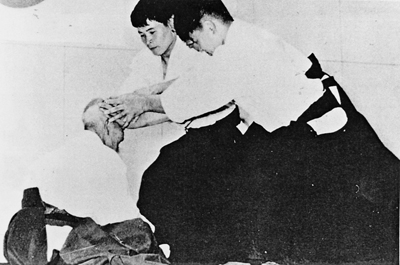 Aikido Founder Morihei Ueshiba O-Sensei demonstrating at the Hibiya Kokaido
Aikido Founder Morihei Ueshiba O-Sensei demonstrating at the Hibiya Kokaido
Nobuyoshi Tamura and Yasuo Kobayashi taking ukemi
Q: You swept his leg? (laughing)
A: Yes. And I’m certain that he fell over. If I had really wanted to be nasty I would have tied him up right there, (laughing) but as soon as he fell over backwards Tohei Sensei popped right back up – that was really impressive. So Tohei Sensei said “I didn’t fall, I crouched down”, but that’s okay. Everybody knows when someone has taken ukemi.
Q: There are a lot of different stories, but that’s what it really was? (laughing)
A: There were many demonstrations – from the small ones with company workers as partners to the big ones. During the time that we were giving demonstrations in smaller places Kenichi Sawai Sensei (澤井健一, the Founder of Taiki Shisei Kenpo / 太氣至誠拳法) and Masatatsu Oyama Sensei (大山倍達, the Founder of Kyokushin Karate / 極真空手) would often be there.
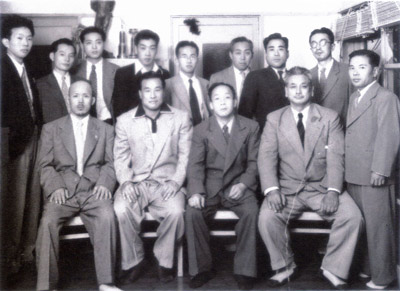 In 1950, after Masatatsu Oyama’s return from the United States
In 1950, after Masatatsu Oyama’s return from the United States
Tatsukuma Ushijima (teacher of Masahiko Kimura) seated front row right
Kenichi Sawai seated front row left next to Masatatsu Oyama
Q: There was that kind of interchange?
A: I often spoke to those two. I also went to visit their dojos in Meiji Jingu and Ikebukuro. I saw Oyama Sensei give a demonstration at a public hall in Asakusa where he rolled up a 10 yen coin.
Q: You saw that with your own eyes?
A: Yes, he didn’t do it in one try, he’d grunt and gradually roll it up a bit at a time. That was really something. At the time I was told “If you weighed 10 kilograms more you’d be able to fell a bull with one blow”. The two of them sometimes also came to the Aikikai dojo. Especially to visit O-Sensei.
Q: Did you ever join the conversations between the Founder, Sawai Sensei and Oyama Sensei?
A: No, I never did that. However, I heard that Oyama Sensei said “Aikido will disappear when O-Sensei dies”. I think that’s so.
Q: You wrote “Aikido was created by Morihei Ueshiba Sensei and will vanish with Morihei Ueshiba’s passing”.
A: That’s right. Nobody could do all of O-Sensei’s Aikido. In the demonstrations that I spoke about earlier O-Sensei said “I am Aikido. When I move it becomes technique.”. In other words, perhaps he thought that it was still too soon for the students to call what they were doing “Aikido”. It’s the same as the blind men touching an elephant, each judging the elephant by the part that they are grasping. It may be odd to state it this way, but it might be best to say that I am “Aikido Kuroiwa-ha” – the same as the practice of naming the sub-groups of the large political parties. I think that everybody’s the same way. Because everybody took something different from the Founder. Since everybody’s abilities and experience was different.
Q: That’s just the path that you’ve walked, isn’t it? That’s way you’ve been able to continue Aikido.
A: That’s right…. For some reason or another I love O-Sensei. There’s no helping it. In the end, whichever way you turn a master teacher is a master teacher. I can’t explain it well in words, though. So I have done my Aikido in my own way.
Gekkan Hiden January 2006
Published by: Christopher Li – Honolulu, HI



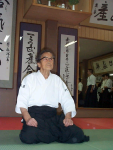

![Aikido, qué no sabemos y por qué no lo sabemos ... [Spanish Version] 武産合気](https://www.aikidosangenkai.org/blog/wp-content/media/takemusu-aiki-hideo-takahashi.jpg)

Leave a Reply